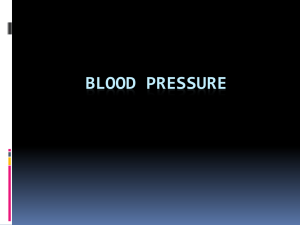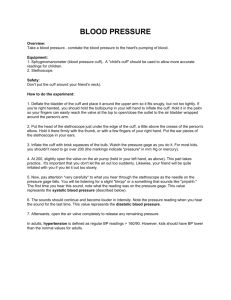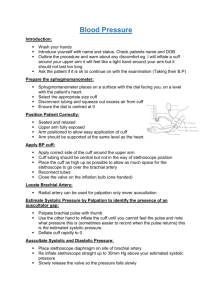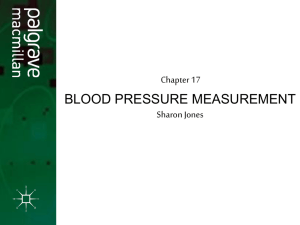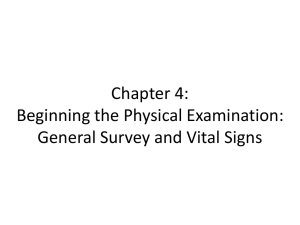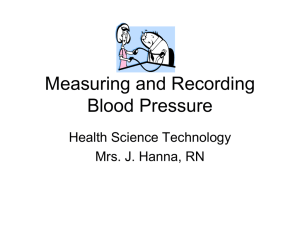Blood Pressure Assessment
advertisement
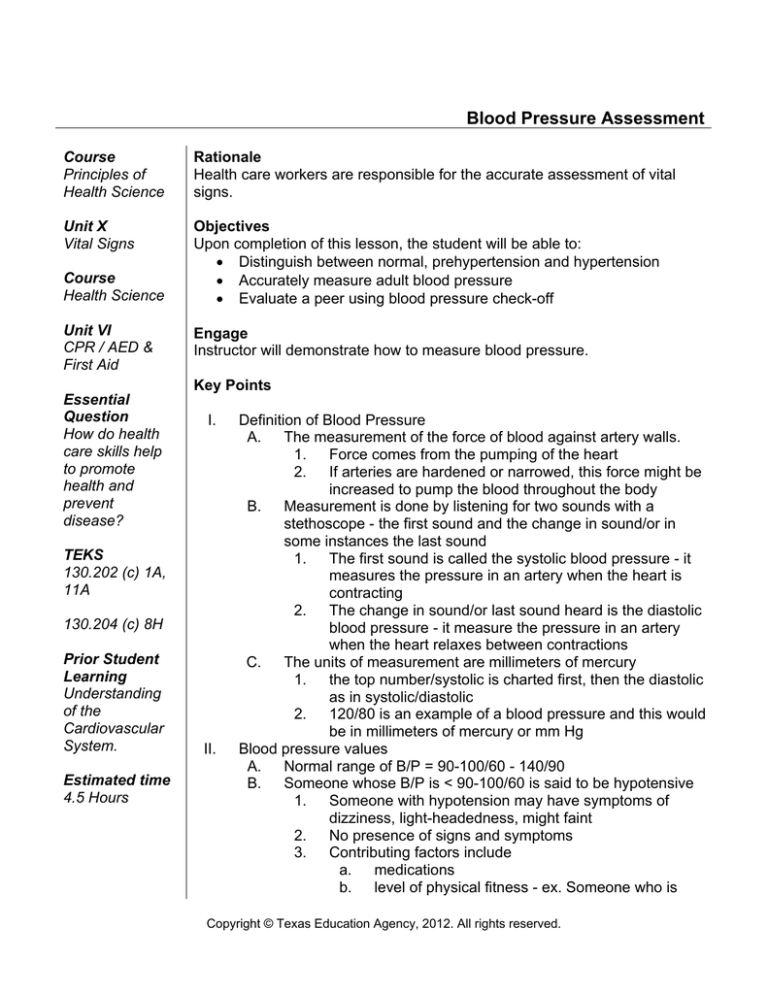
Blood Pressure Assessment Course Principles of Health Science Rationale Health care workers are responsible for the accurate assessment of vital signs. Unit X Vital Signs Objectives Upon completion of this lesson, the student will be able to: Distinguish between normal, prehypertension and hypertension Accurately measure adult blood pressure Evaluate a peer using blood pressure check-off Course Health Science Unit VI CPR / AED & First Aid Engage Instructor will demonstrate how to measure blood pressure. Key Points Essential Question How do health care skills help to promote health and prevent disease? I. TEKS 130.202 (c) 1A, 11A 130.204 (c) 8H Prior Student Learning Understanding of the Cardiovascular System. Estimated time 4.5 Hours II. Definition of Blood Pressure A. The measurement of the force of blood against artery walls. 1. Force comes from the pumping of the heart 2. If arteries are hardened or narrowed, this force might be increased to pump the blood throughout the body B. Measurement is done by listening for two sounds with a stethoscope - the first sound and the change in sound/or in some instances the last sound 1. The first sound is called the systolic blood pressure - it measures the pressure in an artery when the heart is contracting 2. The change in sound/or last sound heard is the diastolic blood pressure - it measure the pressure in an artery when the heart relaxes between contractions C. The units of measurement are millimeters of mercury 1. the top number/systolic is charted first, then the diastolic as in systolic/diastolic 2. 120/80 is an example of a blood pressure and this would be in millimeters of mercury or mm Hg Blood pressure values A. Normal range of B/P = 90-100/60 - 140/90 B. Someone whose B/P is < 90-100/60 is said to be hypotensive 1. Someone with hypotension may have symptoms of dizziness, light-headedness, might faint 2. No presence of signs and symptoms 3. Contributing factors include a. medications b. level of physical fitness - ex. Someone who is Copyright © Texas Education Agency, 2012. All rights reserved. C. extremely fit might be hypotensive, but this is normal for them c. illness d. injury Someone with a B/P greater than 140/90 is said to be hypertensive 1. Hypertension is called the silent killer because there are often no symptoms. Some people might experience headache, pressure in the head, ringing in ears, general feeling of malaise 2. Continued elevation over time may result in a Cerebral Vascular Accident (stroke) 3. Contributing factors may include a. overweight b. emotional upset c. family history d. high salt diet e. pain f. illness g. medications AHA Recommendation High blood pressure, or hypertension, is defined in an adult as a systolic pressure of 140 mm Hg or higher and/or a diastolic pressure of 90 mm Hg or higher. Blood pressure is measured in millimeters of mercury (mm Hg). Blood pressure (mm Hg) Normal Prehypertension Hypertension Systolic (top number) less than 120 120–139 140 or higher 80–89 90 or higher Diastolic (bottom less than number) 80 Mm Hg = millimeters of mercury High blood pressure directly increases the risk of coronary heart disease (which leads to heart attack) and stroke, especially along with other risk factors. High blood pressure can occur in children or adults. It's particularly prevalent in African Americans, middle-aged and elderly people, obese people and heavy drinkers. People with diabetes mellitus, gout or kidney disease have hypertension more often. High blood pressure usually has no symptoms. It's truly a "silent killer." But a Copyright © Texas Education Agency, 2012. All rights reserved. simple, quick, painless test can detect it. http://www.americanheart.org/presenter.jhtml?identifier=4623 III. IV. Instruments necessary to complete the procedure A. Blood pressure cuff/sphygmomanometer 1. This must fit the arm properly. The width of the cuff should approximately equal the width of the upper arm. 2. The gauge should be calibrated and the needle should be on 0 B. Stethoscope Procedure A. Person should be comfortably seated or lying down B. Should have rested for 10-15 minutes prior to the reading C. Arms that are paralyzed, injured, have an IV or shunt should not be used D. Infant blood pressures can be taken on the leg, but adults must use the arm E. Electronic blood pressure equipment can be used - the type used most often in the hospital setting is the Dyna-map F. Excess air should be squeezed out of the cuff G. Cuff should be placed snugly on upper arm. H. Gauge should be easily visualized I. Valve should be closed, but easily able to be opened J. Two techniques for obtaining the pressure 1. Find radial pulse. Pump cuff till pulse no longer palpated. Then pump another 30 mm Hg higher. Place diaphragm of stethoscope on brachial artery about ½ - 1 inch above the elbow. Release the valve and listen for the two measurements - slowly deflating the cuff. 2. Find brachial artery and put diaphragm over the site. Pump cuff to 120 mm Hg and listen for the heart beat. If it is heard, pump another 30 mm Hg and listen again. When the pulse is no longer heard, then pump another 30 mm Hg and slowly deflate, listening for the two measurements. K. If reading is uncertain, wait 30 seconds to 1 minute before remeasuring L. Record the reading and report any abnormalities. If the B/P reading is outside of the normal limits, retake it before reporting the value to a supervisor to be certain of accuracy Activity I. Measure and record partner’s B/P. Blood Pressure Skill Sheet Copyright © Texas Education Agency, 2012. All rights reserved. Assessment Successful completion of Skills Check list Written objective test KEY: Blood Pressure Test Nurse aids Skills exam Rubric for Skills Test or Vital Signs Skills sheet from HOSA Nurse Aid Skills Materials Aneroid sphygmomanometers Stethoscopes Alcohol Swabs or cotton balls and alcohol for disinfecting stethoscopes Any materials chosen to include in supplemental lesson: i.e. urinals, bedpans, IV pole, restraints, etc. KEY: Blood Pressure Test http://www.dads.state.tx.us/providers/NF/credentialing/NATCEP/cna.pdf (Click on Nurse Aide Curriculum) http://www.americanheart.org Accommodations for Learning Differences For reinforcement, the student will list the steps and retake the blood pressure of partner. For enrichment, the student will design a pamphlet and set up a blood pressure booth in a local store, offering blood pressure checks and pamphlets to any interested customers. National and State Education Standards National Health Science Cluster Standards HLC 10.01 Technical Skills Healthcare workers will apply technical skills required for all career specialties. They will demonstrate skills and knowledge as appropriate. TEKS 130.202 (c)(1)(A) convert units between systems of measurement; and 130.202 (c)(11)(A) identify technological equipment used in each of the five systems and relate findings to identified societal risk factors. 130.204 (c)(8)(H) demonstrate first aid, vital signs, cardiopulmonary resuscitation, and automated external defibrillator skills in a laboratory setting. Texas College and Career Readiness Standards English Language Arts Copyright © Texas Education Agency, 2012. All rights reserved. II. B. Understand new vocabulary and concepts and use them accurately in reading writing and speaking. III. B. Develop effective speaking styles for both group and one on one situations. IV. A. Apply listening skills as an individual and as a member of a group in a variety of settings. Mathematics IV. A. 1. Select and use the appropriate type of unit for the attribute being measured. IV. B. 1. Convert from 1 measuring system to another IV. B. 2. Convert within a single measurement system. Copyright © Texas Education Agency, 2012. All rights reserved. WRITTEN TEST: BLOOD PRESSURE NAME: ___________________________ For each of the following, write the correct word that completes the sentence in the space provided on your answer sheet. 1. When measuring blood pressure, you are measuring the ___________ of blood flowing through the arteries. 2. Blood pressure is measured in ______ ______(give the abbreviation). 3. The answer to number 2 stands for ________________ _____________________. 4. When a patient’s blood pressure is higher than normal, we say he has ______________. 5. When a patient’s blood pressure is lower than normal, we say he has _________________. 6. Lower than normal blood pressure occurs when the blood pressure drops below _____/_____. 7. Higher than normal blood pressure occurs when the blood pressure is above _____/_____. 8. - 10. Give three reasons why a blood pressure SHOULD NOT be taken on a particular arm. 8. 9. 10. 11. If a blood pressure has to be repeated, the health care worker should wait a minimum of ____________ seconds. 12. When pumping up a blood pressure cuff, the valve is __________. 13. Blood is carried to the heart by way of ____________. 14. The thicker vessels that carry blood away from the heart are the ___________. 15. Systolic blood pressure measures what? 16. Diastolic blood pressure measures what? 17. When taking a blood pressure the top number is the ____________ pressure. Copyright © Texas Education Agency, 2012. All rights reserved. 18. When taking a blood pressure the bottom number is the ___________ pressure. 19. If the arteries are narrow and hard, the blood pressure is likely to be (higher, lower) than normal. True/False 20. The blood pressure cuff is placed approximately one inch above the radial pulse. 21. The diaphragm of the stethoscope is placed over the brachial artery to hear the blood pressure. 22. It is best to measure the blood pressure while a person is standing. 23. The brachial pulse is located on then thumb side of the arm at the elbow. Identify the following blood pressures as normal or abnormal by writing the appropriate word in the space on your answer sheet. 24. 60/132 25. 154/72 26. 110/64 27. 88/52 28. 186/96 Fill in the Blank: For each of the following, write the correct word(s) in the space provided on your answer sheet. 29. Consistently elevated blood pressure might result in a stroke or _____________ _________________ _________________. 30. True/False. Blood pressure can be increased by high salt diet, emotion, and illness. Copyright © Texas Education Agency, 2012. All rights reserved. KEY: WRITTEN TEST: BLOOD PRESSURE 1.force 2. mm Hg 3. millimeters of mercury 4. hypertension 5. hypotension 6. 90-100/60 7. 140-90 8. - 10. Shunt, IV, paralysis, pain, injury 11. 30 seconds 12. closed 13. veins 14. arteries 15. contraction of heart 16. relaxation of heart between contractions 17. systolic 18. diastolic 19. higher 20. False 21. True 22. False 23. False 24. Abnormal 25. Abnormal 26. Normal 27. Abnormal 28. Normal 29. Cerebral Vascular Accident/Cerebrovascular Accident 30. True Copyright © Texas Education Agency, 2012. All rights reserved. NURSE AIDE SKILLS EXAM BLOOD PRESSURE/procedural guideline #47** Adapted from the Texas Department of Human Services Nurse Aide Curriculum. (Note to Nurse Examiner: Instruct nurse aide to inflate cuff no more than 2 times to obtain reading. Wait 30 seconds before each re-inflation. Use teaching stethoscope if available.) **If students do not complete Check 1, peer evaluation, they will receive a 0 for the Check 2 Skill Test. The initials of the peer performing the check must appear above the check 1 column. PROCEDURE 1. Properly cleans hands before procedure as appropriate. 2. Identifies resident, explains procedure to resident, and encourages resident to participate as appropriate. 3. Assembles appropriate equipment before procedure such as correct sized cuff. a. stethoscope b. sphygmomanometer 4. Provides for resident’s privacy as appropriate. 5. INSURES RESIDENT’S SAFETY. a. bed wheels locked b. side rails up 6. Provides adequate lighting. 7. Assists resident into a comfortable sitting or recumbent position with forearm relaxed and supported in a palm-up position, approximately at the level of the heart. 8. Rolls resident’s sleeve up about 5 inches above the elbow and applies the cuff around the upper arm just above the elbow. 9. Cleans earpiece of stethoscope appropriately and places in ears. 10. LOCATES BRACHIAL ARTERY and places blood pressure cuff over artery, applying cuff smoothly and snugly. 11. Tightens valve attached to air bulb. 12. 1)Quickly pumps air into cuff, while 2)palpitating radial artery with finger tips, 3)to about 20-30 mm above the point where POSSIBLE POINTS CHECK 1 CHECK 2 4 _________ _________ 3 _________ _________ 2 _________ _________ 1 _________ _________ 2 _________ _________ 1 _________ _________ 4 _________ _________ 2 _________ _________ 2 _________ _________ 2 _________ _________ 1 _________ _________ 5 _________ _________ Copyright © Texas Education Agency, 2012. All rights reserved. the pulse ceased to be detected. 4)Places stethoscope over brachial artery now 5)making sure NOT to touch the B/P cuff. 13. 1)Opens valve on air bulb, 2)letting air escape slowly and evenly, while 3)watching gauge and 4)listening for pulse sounds. 5)Notes the systolic pressure (when the first regular sound is 6 _________ _________ heard) and the 6)diastolic pressure (when the pulse changes from a loud beat to a faint murmur, or if no change is heard until it disappears.) 14. Records the systolic and diastolic pressure. (Instructions to Examiner: Ask nurse aide to record blood pressure, 2 _________ _________ then examiner checks blood pressure in same arm and records results. Use teaching stethoscope if available.) NURSE EXAMINER’S RESULTS __________ NURSE AIDE’S RESULTS___________ 15. NURSE AIDES RECORDED BLOOD PRESSURE READING (BOTH SYSTOLIC AND DIASTOLIC) MEASURES 2 _________ _________ NO MORE THAN 10 MM HG. FROM NURSE EXAMINER’S BLOOD PRESSURE MEASUREMENT. 16. Removes blood pressure cuff and leaves 2 _________ _________ resident in a position of comfort. 17. Cleans stethoscope with alcohol pads 2 and puts away B/P cuff appropriately. TOTAL POSSIBLE POINTS = 43 TOTAL POINTS EARNED = _________ Copyright © Texas Education Agency, 2012. All rights reserved.
